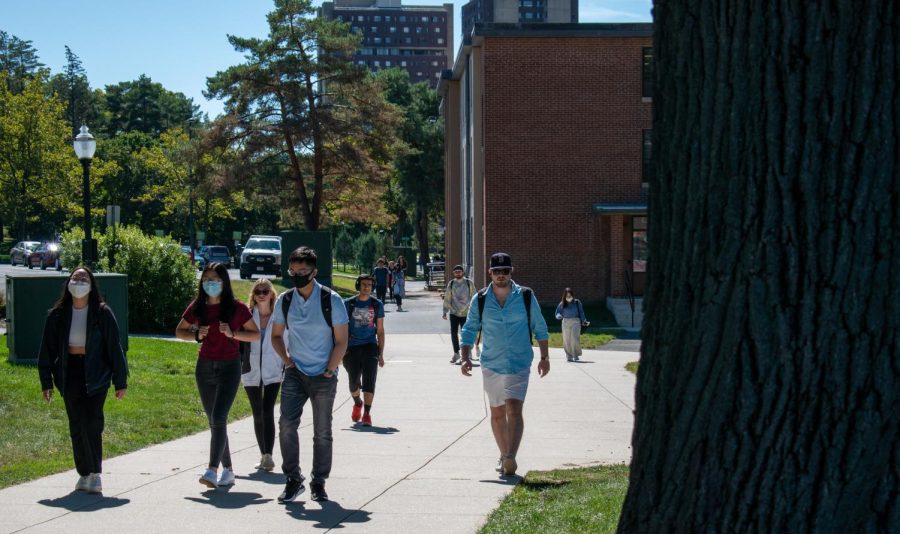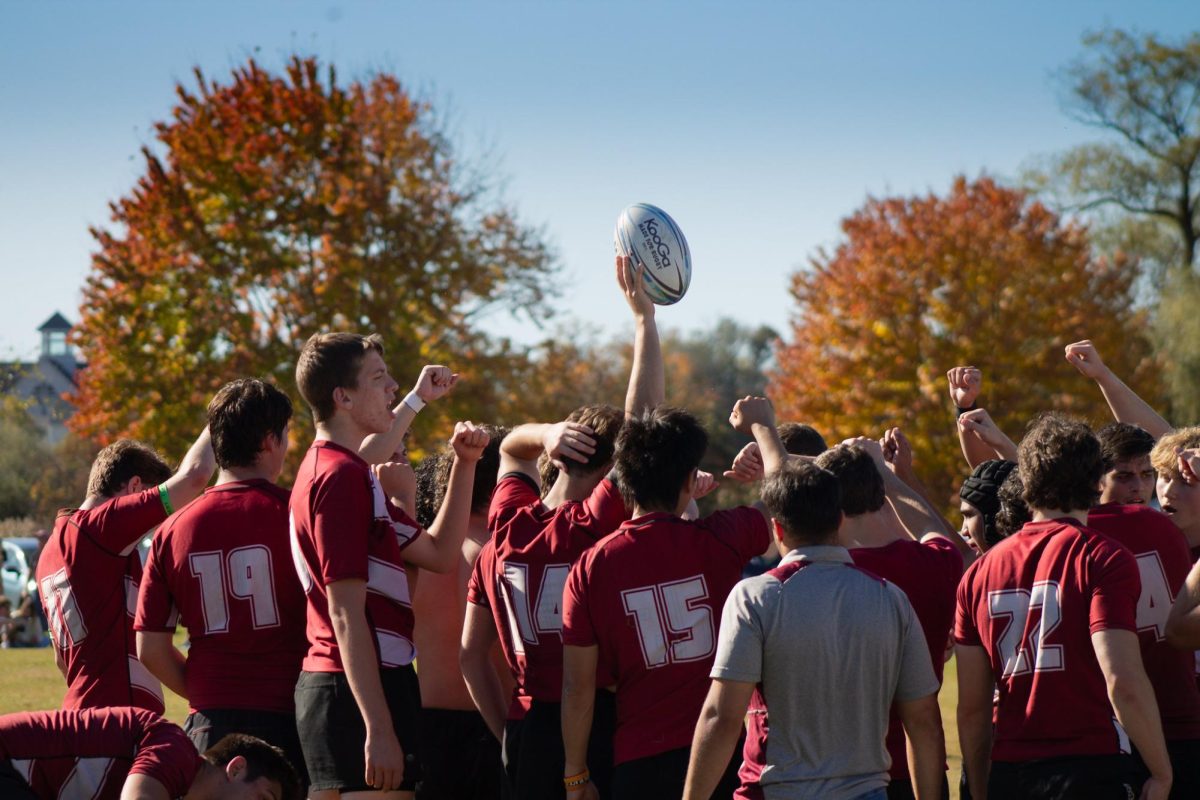They say that COVID-19 is the “new normal.”
The pandemic has become so consuming that I can describe it with a “the,” similar to characters in a middling science fiction novel referring to “the incident” or “the shift.” It has swallowed our public consciousness to such a degree that it’s still hard to talk about a world that doesn’t have the pandemic at the center of political and social discourse. But outside of the United States, some countries are beginning to contemplate the unthinkable.
Denmark, for one, is doing away with COVID-19 restrictions altogether. Despite the fact that it has one of the highest case rates in the world, Danish policymakers have observed that hospitalizations and death haven’t risen correspondingly, a trend that has been observed worldwide due to Omicron’s lower severity as well as high vaccine uptake. Denmark isn’t alone; countries across the world are loosening and casting off long-held restrictions. Even New Zealand, long one of the leaders in lockdowns and quarantines, has announced a five-phase plan for significantly easing its restrictions.
While states, municipalities and businesses around America continue to uphold mask mandates and implement vaccine mandates, one of the central sites of continued COVID-19 restrictions have been colleges and universities. The University of Massachusetts is no exception.
UMass, however, has been relatively lenient in terms of its COVID-19 restrictions. Our restrictions are relatively small-scale and largely limited to indoor mask mandates and mandatory quarantining per positive case. Many colleges, especially elite universities such as those in the Ivy League, have been far more stringent. Whether it’s been starting the semester virtually, mandatory outdoor masking, closing dining halls or restricting student access to off-campus buildings, some administrations have made moves that can only be described as hypochondriac in nature. For instance, Yale University banned students from dining outside just last month, sparking widespread backlash.
I don’t want to talk about those universities, however. I’d like to focus on UMass–our comparatively libertarian restrictions are still a presence in everyday life here at the University. Therefore, I’ll be focusing on two things in this article. First of all, what serious dangers does the virus still pose to the UMass community? And secondly, to what degree are the remaining restrictions warranted, and if they aren’t, what should the “new normal” look like?
Mild-mannered
Week after week, I find the COVID-19 update email from the UMass Public Health Promotion Center waiting in my inbox to be read. And week after week, I find the same phrase in the email, repeated like an incantation.
“Most cases are of short-to-moderate duration resulting in mild-to-moderate illness, and there are no current hospitalizations.”
For a population in large part composed of young adults who are almost universally vaccinated and boosted, it’s no surprise that COVID-19 isn’t a serious threat. Vulnerability to the coronavirus is highly stratified by age, and is lowered by a considerable amount for each vaccine taken. With the lower virulence of the Omicron strain considered, COVID-19 is no longer the risk it once was to the average college student.
Of course, students aren’t the only people on campus. Thousands of staff and faculty are also subject to COVID-19 restrictions on campus. But even vaccinated older adults are far less vulnerable to the coronavirus than their unvaccinated counterparts. Vaccination gives people a risk profile equivalent to their unvaccinated counterparts who are several decades younger than them, though of course the nature of the virus means that they will be more vulnerable than the student population to severe illness, hospitalization and death.
There are thousands of people dying of COVID-19 in the United States every day, but the average person in this demographic starkly contrasts from those covered by UMass coronavirus protocol. People on campus are comparatively younger, far more vaccinated and far less vulnerable to the ravages of the coronavirus.
Under the mask
Masking has been a culture war flashpoint for over a year and a half, so it’s no wonder that the “debate” over mask mandates is at this point based far more in conjecture than in fact. While much of the blame for this lays at the feet of anti-maskers, some must also be directed to health authorities such as the CDC who have sent vague and contradictory messages that sometimes overstep the bounds of what honest science communication should be. The idea that cloth masks are essentially ineffectual, for example, would have been evident to someone reading the latest research in 2020, but it’s taken until 2022 for public health messaging to discourage their use.
In any case, research shows a significant effect of mask-wearing on reducing case rates, though more thorough randomized control trials have shown smaller effect sizes. Although, of the two large RCTs that have been done on masking for COVID-19 thus far, one of them only focuses on masking’s protective effect on the wearer, which is said to be less significant than its ability to prevent transmission from the wearer. Overall, an editorial in the British Medical Journal states, the quality of evidence should be graded as “low or very low.”
The evidence is mixed at best when it comes to masking at primary and secondary schools. Unfortunately, there’s been less research assessing college campuses, so we have to use the studies at hand for an imperfect proxy. Overall, I think it’s a safe conclusion that masking has an impact, though the magnitude of that impact could be anywhere from a 10 percent to an 80 percent reduction in cases.
But those who claim that mask mandates have no drawbacks are wrong. I faithfully comply with UMass masking policy, and the drawbacks of masking are visible to me every day. From restricting social interactions to fogging up glasses, the daily annoyances of masking are small on their own but are not to be understated.
In an environment where people were more vulnerable to the worst effects of COVID-19 like a hospital or nursing home, I wouldn’t dispute a mask mandate. But UMass is not one of those environments. There will be a point in the future when we can and should be free to make the choice whether to wear a mask around campus. Massachusetts Gov. Charlie Baker, for one, has set that time for K-12 schools at the end of this month. What about colleges then? It’s up to us to decide.
Long COVID
Critics argue that there is more to COVID-19 effects than just the initial risk of illness. Long COVID, an all-encompassing term for the long-term persistence of COVID-19 symptoms after the infection abates from difficulty concentrating to loss of smell, has gotten much attention in the media as of late. Like other post-viral syndromes, it’s not straightforward to pin down the prevalence and intensity of long COVID. Some say long COVID quietly immiserates the lives of millions of Americans, while others believe it to be little more than a psychosomatic syndrome.
At this point in the pandemic, once-blurry facts about long COVID have begun to come into sharper focus. For one, it is no longer tenable to suggest that post-COVID suffering is purely psychosomatic. The vast preponderance of evidence shows that even when rigorous controls are implemented, the majority of long COVID sufferers are feeling the effects of a real, and often quite serious disease.
However, unreliable media reports of large fractions of those infected with COVID-19 suffering from long COVID are often based on less rigorous studies that don’t use control groups to find the base rate of symptoms in non-infected people. Even when the studies are rigorous, such as a 2021 meta-analysis of the prevalence of long COVID, headlines often leave out critical context. While the article trumpets that more than half of COVID-19 sufferers have long-term symptoms, scrolling down reveals that 79 percent of patients studied were hospitalized, far above the average rate of around 2 percent and only 0.4 percent for those younger than 40.
A July report from the British Office of National Statistics concluded the true rate of incidence of long COVID to be somewhere around 13.7 percent at 12 weeks post-infection, but relatively lower for young populations and higher for older. Compared to other studies, there is a vast range of values to come to these conclusion from.
The data is also becoming more and more clear that vaccination protects against long COVID. A large study that came out of Israel found that vaccination more than halved the risk of long COVID symptoms. Another study with a sample of more than 200,000 people suggests that the benefit of vaccines may be even greater than the Israelis’ findings. On a pessimistic note, a study of 10,000 breakthrough infections found that there was no effect of vaccination on long COVID prevalence. Overall, though, the balance of evidence suggests vaccines have a significant effect, however, much of this data is still preliminary.
Research demonstrates that long COVID is far less common and virulent among children and adolescents. A recent study characterized long COVID in children as “rare and mainly of short duration.” Unfortunately, those who are college-age and above, there’s not as much youthful invulnerability to go around. That said, long COVID is still somewhat less common among younger adults than older cohorts. While the exact degree to which this is true is debated, long COVID population studies show that of those who are infected with COVID-19, a smaller fraction of people under 30 report long-term symptoms. Most reassuringly of all, a Danish study of young adults aged 15 to 18 found those infected with COVID-19 reported higher quality of life post-infection than the control group.
As we’ve seen, long COVID certainly shouldn’t be dismissed. There are undoubtedly millions of people nationwide who are coping daily with the long-term effects of COVID-19 infection. However, the existence of long COVID shouldn’t have impact current on-campus policies. For an overwhelmingly young and vaccinated population such as UMass’, COVID-19 effects are far milder, both during and after infection.
Looking ahead
The question of returning to normalcy should not be a question of if, but a question of when. Excluding the quixotic objections of “Zero Covid” enthusiasts, the coronavirus is not going to be eradicated and will inevitably become an endemic. We should view restrictions in light of the fact that the conditions as we know them today are how they will be for the foreseeable future. If masking and extended quarantine procedures aren’t going to be continued forever, and they shouldn’t, campus administration should set out a concrete plan for returning to normalcy in 2022.
The loosening of pandemic restrictions should be accompanied by the continuation of rigorous monitoring of case count and severity. I would additionally propose that disease surveillance is expanded to monitor long COVID among the student body, both to assess if the costs of removing restrictions outweigh benefits and to provide more data points for the pressing questions in long COVID research. Of course, if a new strain emerges with a significantly higher degree of transmission or serious illness, UMass should still be prepared to take necessary actions to preserve the basic health of its student body.
You may notice that I’m not advocating for the end of pandemic restrictions with full certainty. That’s because, like almost everything we do in life, there will be a degree of unavoidable risk and uncertainty that comes with action. The fallacy that many policymakers and administrators make, however, is their ignorance with the risk and uncertainty that comes with inaction and continued restrictions. No matter what route we choose to take, there will always be questions ahead. But we must follow the wisest course of action, even if the path ahead looks murky.
Dylan Partner can be reached at [email protected].




















Dale Leone • Feb 17, 2022 at 12:59 pm
This is a whole lot of nothing. I think generally speaking most can agree that masks won’t last forever. But it seems this entire opinion was written to express discomfort with wearing masks. You constantly contradict yourself arguing that masks shouldn’t be required and should be optional because if state guidance from governor Baker, but then you point out how masks have been effective here at UMass. The protection of masks and vaccines are the reason why UMass has been able to keep relative low cases. While you argue now or the foreseeable future seems to be the perfect time to rid the masks, health experts disagree. Even then, if we get rid of the masks, the university has to ensure people follow up with vaccinations, and other health measures to ensure no outbreak here in the future. The wisest course of action would be to continue masking and suffer with our discomfort. Obviously accommodations can and will be made. Perhaps easing up restrictions in living spaces can be a start. But there is no reason masks should be ditched in the classroom.